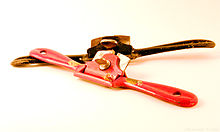Spokeshave
You can help expand this article with text translated from the corresponding article in German. (April 2015) Click [show] for important translation instructions.
|


A spokeshave is a tool used to shape and smooth wooden rods and shafts – often for use as wheel spokes, chair legs (particularly complex shapes such as the cabriole leg),[1] self bows, and arrows. It can also be used to carve canoe or kayak paddles.
Modern
Spokeshaves can be made from flat-bottom, concave, or convex soles, depending on the type of job to be performed. Spokeshaves can include one or more sharpened notches along which the wooden shaft is pulled in order to shave it down to the proper diameter. Historically, spokeshave blades were made of metal, whilst the body and handles were wood. An early design consisted of a metal blade with a pair of tangs to which the wooden handles were attached, as with a drawknife. Unlike a drawknife, but like a plane, spokeshaves typically have a sole plate that fixes the angle of the blade relative to the surface being worked. By the twentieth century metal handles and detachable blades had become the most common.
Travisher
A convex, wooden, variant of the spokeshave is called a travisher.[2]
Prehistory
Prehistoric spokeshaves were made of stone. In archaeology, the term spokeshave is used to describe a tool, usually a uniface, that has at least one retouched lunate notch in one edge. In a sense, the term is a descriptive "catch-all" category, since it is difficult to determine if this was actually the way in which such a tool was used; the categorization is based entirely on the appearance of the tool.
See also
References
- ^ Encyclopedia of Furniture Making; by Ernest Joyce and Alan Peters
- ^ "Travisher". Highland Woodworking.
